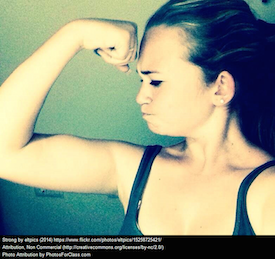5.3 Elements of Persuasion - Strong Position
| Site: | Cowichan Valley School District - Moodle |
| Course: | ELA5, CSS, Sferrazza |
| Book: | 5.3 Elements of Persuasion - Strong Position |
| Printed by: | Guest user |
| Date: | Wednesday, 17 December 2025, 1:29 PM |
Learning Targets
By the end of this lesson, you should be able to say YES to the following questions.
- Can you understand the elements of persuasive writing?
- Can you identify the importance of these elements in creating quality persuasive writing?

Strong Position
 Persuasive writing takes a strong stand. The message is clear.
Persuasive writing takes a strong stand. The message is clear.
Read the following statements. Do they sound very persuasive?
“Well, it may possibly be a good idea to buy Fluffy Flakes. I hear some pets like them, but then some pets don’t.”
“If you could vote for me for class president, I think it perhaps will work out. I think I might do an okay job.”
“Maybe you should buy this bike. I don’t know too much about this model. The wheels look like they work.”
These statements sound weak and wishy-washy. They are not very convincing.
Examples of a Strong Stand
 Persuasive writing shows strong support of a product, person, or idea. The text will show that the author either strongly agrees or disagrees with the topic. Here are the earlier sentences reworked. See if you can recognize the persuasive technique.
Persuasive writing shows strong support of a product, person, or idea. The text will show that the author either strongly agrees or disagrees with the topic. Here are the earlier sentences reworked. See if you can recognize the persuasive technique.
“Two out of three veterinarians recommend Fluffy Flakes. With 50% more vitamins and nutrients, Fluffy Flakes are all your furry friends need."
“Vote for change! Vote for an exciting and eventful year for everyone! Vote for me for class president!"
"The Royal 350 bicycle provides the rider with the highest levels of luxury and comfort. Only a select few can afford this level of sophistication and style. The Royal 350 is the king of bikes.”
Delete "I Think..."
To make your stance stronger, you must take out I-statements like:
- I think...
- I believe...
- I know...
- I say...
Using I-statements makes your writing weaker because it highlights this information as your opinion. Also, by saying, "I think" or "I believe," it shows a level of uncertainty. By cutting I-statements out, it makes your writing feel more like a fact. People are swayed more by facts than opinion.
Example: I think it is a good idea to read a book every day for at least 30 minutes.
Change to:
Example: It is a good idea to read a book every day for at least 30 minutes.
Go to your Persuasive Writing Journal and do Journal #3: I Think.
Descriptive Language
One thing you will also notice in the examples is the use of descriptive language. There are exciting adjectives and more active verbs.There is also the use of literary devices.
Example:
"The Royal 350 bicycle provides the rider with the highest levels of luxury and comfort. Only a select few can afford this level of sophistication and style. The Royal 350 is the king of bikes.”
E.g. The Royal 350 is the king of bikes. This metaphor helps create a picture in your mind.
Alliteration is when the first letter sounds are repeated. (Crazy kids like cool catapults.) Can you find alliteration in one of the ad examples below?
Examples:
“Two out of three veterinarians recommend Fluffy Flakes. With 50% more vitamins and nutrients, Fluffy Flakes are all your furry friends need."
“Vote for change! Vote for an exciting and eventful year for everyone! Vote for me for class president!"
Using persuasive techniques makes ads more powerful and persuasive. The weaker bike ad mentioned the wheels working:
“Maybe you should buy this bike. I don’t know too much about this model. The wheels look like they work.”
This is not going to catch someone's attention.
The second version used snob appeal with words like "luxury" and "comfort" to make it sound more attractive.
"The Royal 350 bicycle provides the rider with the highest levels of luxury and comfort. Only a select few can afford this level of sophistication and style. The Royal 350 is the king of bikes.”
The third reason is that all modal verbs and weak adverbs were cut out. Words like maybe, might, possibly, etc. were cut out.
For more details on modal verbs, click to the next page.
Modal Verbs
Modal verbs are used when we believe something is certain, likely, or even possible.
Commonly used modal verbs are can, could, may, might, will, and must.
Look at these sentences and see if you can tell which are stronger, more positive modal verbs and which are weaker modal verbs.
- You can do it.
- You could do it.
- You may do it.
- You might do it.
- You will do it.
- You must do it.
Weaker Modal Verbs
Could, might, and may are used when you think something might happen in the future, but you’re not positive:
- Based on the forecast, it might rain.
- You may want to buy this.
- It could be a good idea.
Can is used for general statements about what might happen:
- It can be hot in summer. (Can = sometimes hot in summer)
Stronger Modal Verbs
Must and will show we are sure about our beliefs or that something has to happen:
You must buy this.
You will buy this.
Based on the forecast, it must rain.
Based on the forecast, it will rain.
Go to your Persuasive Writing Journal and do Journal #4: Modal Madness.
Choose Strong Adverbs
Possibly, perhaps, maybe, possibly, and definitely are all adverbs. They change the power of a verb in different ways.
It will possibly rain. (small chance of rain, think 10-30% chance)
Perhaps it will rain. (think 30-40% chance of rain)
Maybe it will rain. (think 50% chance of rain)
It will probably rain. (chances are good it will rain, think 80-90%)
It will definitely rain. (for sure it will rain, think 100%)
If you want to be persuasive, make sure to cut out weak adverbs. It is better to just have a strong verb on its own. Definitely is definitely the best choice.
 Complete the assignment Standing Strong! to practise changing weak wishy-washy sentences to strong persuasive sentences.
Complete the assignment Standing Strong! to practise changing weak wishy-washy sentences to strong persuasive sentences.